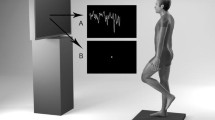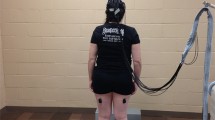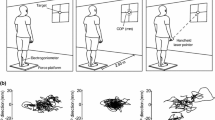Abstract
In an earlier posturographic investigation (Collins and De Luca 1993) it was proposed that open-loop and closed-loop control mechanisms are involved in the regulation of undisturbed, upright stance. In this study, stabilogram-diffusion analysis was used to examine how visual input affects the operational characteristics of these control mechanisms. Stabilogram-diffusion analysis leads to the extraction of repeatable center-of-pressure (COP) parameters that can be directly related to the resultant steady-state behavior and functional interaction of the neuromuscular mechanisms underlying the maintenance of erect posture. Twenty-five healthy male subjects (aged 19–30 years) were included in the study. An instrumented force platform was used to measure the time-varying displacements of the COP under each subject's feet during quiet standing. The subjects were tested under eyes-open and eyes-closed conditions. The COP trajectories were analyzed as one-dimensional and two-dimensional random walks, according to stabilogram-diffusion analysis. Using this technique, it was found that visual input affects the performance of the postural control system in one of two different ways — either it significantly modifies the steady-state behavior of the open-loop postural control mechanisms, or it significantly alters the characteristics of the other closed-loop feedback mechanisms that are involved in balance control. This result is interpreted as an indication that the visual system is integrated into the postural control system in one of two different ways. The experimental population was roughly evenly divided between these two schemes. For the first group (13 of 25 subjects), visual input principally caused a decrease in the “effective” stochastic activity of the open-loop control mechanisms in both the mediolateral and anteroposterior directions. For the second group (12 of 25 subjects), visual input caused an increase in the effective stochastic activity and uncorrelated behavior of the closed-loop control mechanisms in the anteroposterior direction only. On the basis of these results, it is hypothesized that visual input, in both schemes, serves to decrease the stiffness of the musculoskeletal system. In the former case, this may be accomplished by decreasing the level of muscular activity across the joints of the lower limb, whereas, in the latter case, reduced stiffness may be achieved by reducing the gain(s) of the other postural feedback mechanisms, i.e., the proprioceptive and/or vestibular systems. Using stabilogram-diffusion analysis, it was also found that the two groups of subjects behaved similarly under eyes-closed conditions. This result suggests that the open-loop postural control mechanisms and reflex-based feedback systems, respectively, of healthy, young individuals are organized in functionally equivalent ways.
Similar content being viewed by others
References
Amblard B, Crémieux J, Marchand AR, Carblanc A (1985) Lateral orientation and stabilization of human stance: static versus dynamic visual cues. Exp Brain Res 61:21–37
Asten WNJC van, Gielen CCAM, Denier van der Gon JJ (1988) Postural adjustments induced by simulated motion of differently structured environments. Exp Brain Res 73:371–383
Berthoz A, Lacour M, Soechting JF, Vidal PP (1979) The role of vision in the control of posture during linear motion. Prog Brain Res 50:197–209
Black FO, Wall C, Rockette HE, Kitch R (1982) Normal subject postural sway during the Romberg test. Am J Otolaryngol 3:309–318
Bronstein AM (1986) Suppression of visually evoked postural responses. Exp Brain Res 63:655–658
Bronstein AM, Hood JD, Gresty MA, Panagi C (1990) Visual control of balance in cerebellar and Parkinsonian syndromes. Brain 113:767–779
Cernacek J (1980) Stabilography in neurology. Agressologie 21D:25–29
Collins JJ, De Luca CJ (1993) Open-loop and closed-loop control of posture: a random-walk analysis of center-of-pressure trajectories. Exp Brain Res 95:308–318
Collins JJ, De Luca CJ (1994) Random walking during quiet standing. Phys Rev Lett 73:764–767
Collins JJ, De Luca CJ (in press) Upright, correlated random walks: a statistical-biomechanics approach to the human postural control system. CHAOS
De Luca CJ, LeFever RS, McCue MP, Xenakis AP (1982) Control scheme governing concurrently active human motor units during voluntary contractions. J Physiol (Lond) 329:129–142
Dichgans J, Mauritz KH, Allum JHJ, Brandt T (1976) Postural sway in normals and ataxic patients: analysis of the stabilizing and destabilizing effects of vision. Agressologie 17C:15–24
Diener HC, Dichgans J, Bacher M, Gompf B (1984) Quantification of postural sway in normals and patients with cerebellar diseases. Electroencephalogr Clin Neurophysiol 57:134–142
Dietz V (1992) Human neuronal control of automatic functional movements: interaction between central programs and afferent input. Physiol Rev 72:33–69
Einstein A (1905) Über die von der molekularkinetischen Theorie der Wärme geforderte Bewegung von in ruhenden Flüssigkeiten suspendierten Teilchen. Ann Phys 322:549–560
Feder J (1988) Fractals. Plenum, New York
Grillner S (1972) The role of muscle stiffness in meeting the changing postural and locomotor requirements for force development by the ankle extensors. Acta Physiol Scand 86:92–108
Hasan SS, Lichtenstein MJ, Shiavi RG (1990) Effect of loss of balance on biomechanics platform measures of sway: influence of stance and a method for adjustment. J Biomech 23:783–789
Ishida A, Imai S (1980) Responses of the postural-control system to pseudorandom acceleration disturbances. Med Biol Eng Comput 18:433–438
Johansson R, Magnusson M, Akesson M (1988) Identification of human postural dynamics. IEEE Trans Biomed Eng 35:858–869
Joyce GC, Rack PMH (1974) The effects of load and force on tremor at the normal human elbow joint. J Physiol (Lond) 240:375–396
Kirby RL, Price NA, MacLeod DA (1987) The influence of foot position on standing balance. J Biomech 20:423–427
Leroux J, Baron JB, Bizzo G, Bessineton JC, Gueguen C, Noto R, Pacifici M (1973) Power spectrum density of lateral and anteroposterior spontaneous motions of the center of gravity of the man standing up. Agressologie 14C:57–63
Lestienne F, Soechting JF, Berthoz A (1977) Postural readjustments induced by linear motion of visual scenes. Exp Brain Res 28:363–384
Maki BE, Holliday PJ, Fernie GR (1987) A postural control model and balance test for the prediction of relative postural stability. IEEE Trans Biomed Eng 34:797–810
Mandelbrot BB, van Ness JW (1968) Fractional Brownian motions, fractional noises and applications. SIAM Rev 10:422–437
Massion J (1992) Movement, posture and equilibrium: interaction and coordination. Prog Neurobiol 38:35–56
Montroll EW, Lebowitz JL (1987) Fluctuation phenomena. North-Holland, Amsterdam
Nashner L, Berthoz A (1978) Visual contribution to rapid motor responses during postural control. Brain Res 150:403–407
Njiokiktjien C, De Rijke W (1972) The recording of Romberg's test and its application in neurology. Agressologie 13C:1–7
Paulus WM, Straube A, Brandt T (1984) Visual stabilization of posture: physiological stimulus characteristics and clinical aspects. Brain 107:1143–1163
Paulus W, Straube A, Krafczyk S, Brandt T (1989) Differential effects of retinal target displacement, changing size and changing disparity in the control of anterior/posterior and lateral body sway. Exp Brain Res 78:243–252
Prochazka A (1989) Sensorimotor gain control: a basic strategy of motor systems? Prog Neurobiol 33:281–307
Ring C, Nayak USL, Isaacs B (1989) The effect of visual deprivation and proprioceptive change on postural sway in healthy adults. J Am Geriatr Soc 37:745–749
Saupe D (1988) Algorithms for random fractals. In: Peitgen H-O, Saupe D (eds) The science of fractal images. Springer, Berlin Heidelberg New York, pp 71–136
Shlesinger MF, West BJ (1984) Random walks and their applicaions in the physical and biological sciences. American Institute of Physics, New York
Soechting JF, Berthoz A (1979) Dynamic role of vision in the control of posture in man. Exp Brain Res 36:551–561
Theiler J, Eubank S, Longtin A, Galdrikian B, Farmer JD (1992) Testing for nonlinearity in time series: the method of surrogate data. Physica D 58:77–94
Vidai PP, Berthoz A, Millanvoye M (1982) Difference between eye closure and visual stabilization in the control of posture in man. Aviat Space Environ Med 53:166–170
Voss RF (1988) Fractals in nature: from characterization to simulation. In: Peitgen H-O, Saupe D (eds) The science of fractal images. Springer, Berlin Heidelberg New York, pp 21–70
Werness SAS, Anderson DJ (1984) Parametric analysis of dynamic postural responses. Biol Cybern 51:155–168
Author information
Authors and Affiliations
Rights and permissions
About this article
Cite this article
Collins, J.J., De Luca, C.J. The effects of visual input on open-loop and closed-loop postural control mechanisms. Exp Brain Res 103, 151–163 (1995). https://doi.org/10.1007/BF00241972
Received:
Accepted:
Issue Date:
DOI: https://doi.org/10.1007/BF00241972




